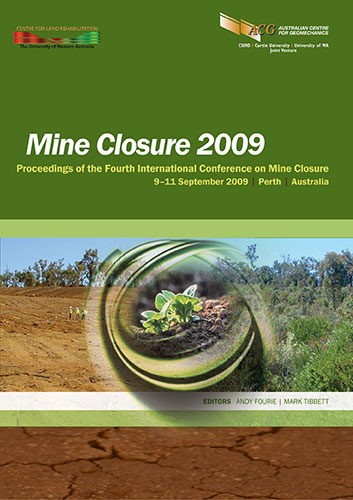Water quality within mine waste impoundments at an incompletely remediated Cu-Pb-Zn mine site in Korea

|
Authors: Ahn, JS; Cheong, Y-W; Yim, G-J |
DOI https://doi.org/10.36487/ACG_repo/908_19
Cite As:
Ahn, JS, Cheong, Y-W & Yim, G-J 2009, 'Water quality within mine waste impoundments at an incompletely remediated Cu-Pb-Zn mine site in Korea', in AB Fourie & M Tibbett (eds), Mine Closure 2009: Proceedings of the Fourth International Conference on Mine Closure, Australian Centre for Geomechanics, Perth, pp. 263-271, https://doi.org/10.36487/ACG_repo/908_19
Abstract:
Many of the closed mines in Korea have been abandoned without proper environmental protection measures. Some failures in preventing contamination from mine wastes have been reported even where remediation works were conducted. In this study, water quality variation in borehole groundwater and surface runoff was investigated on a seasonal basis within the waste impoundments at a mine site where previous rehabilitation measures were unsuccessful. The groundwater was typical acid mine drainage with pH 3.5–4.6 and high total dissolved solids (TDS) (390–3330 mg/L) during the dry season, and decreases of pH to 2.7–3.6 and increases in metal contents during the rainy season. Surface runoff showed a similar pattern of water quality variation. Good correlations were found between the concentrations of major and trace elements measured. It is suggested that dissolution of soluble secondary salts caused by flushing of weathered waste rocks and tailings directly influenced the water quality within the waste impoundments. Increases in acid and metal concentrations and their loadings from mine wastes are anticipated in the rainy season. It is necessary to apply more appropriate cover systems on waste rocks and tailings with the consideration of more extreme conditions in the study mine.
References:
Gomes, M.E.P. and Favas, P.J.C. (2006) Mineralogical controls on mine drainage of the abandoned Ervedosa tin mine
in north-eastern Portugal, Applied Geochemistry 21, pp. 1322–1334.
Hammarstrom, J.M., Seal II, R.R., Meier, A.L. and Kornfeld, J.M. (2005) Secondary sulfate minerals associated with
acid drainage in the eastern US: recycling of metals and acidity in surficial environments, Chemical Geology
215, pp. 407–431.
Jerz, J.K. and Rimstidt, J.D. (2003) Efflorescent iron sulfate minerals: Paragenesis, relative stability, and environmental
impact, American Mineralogist 88, pp. 1919–1932.
KIGAM (2007) A study on prevention of contamination of soil and water at the abandoned metal mines, Korea Institute
of Geoscience and Mineral Resources NP2007-005-2007(1), 163 p.
Nordstrom, D.K. (2007) Effects of seasonal and climatic change on water quality from acid rock drainage in the western
United States, IMWA Symposium 2007: Water in Mining Environments, R. Cidu & F. Frau (eds), Cagliari,
Italy, pp. 11–16.
Smuda, J., Dold, B., Frise, K., Morgenstern, P. and Glaesser, W. (2007) Mineralogical and geochemical study of
element mobility at the sulfide-rich Excelsior waste rock dump from the polymetallic Zn-Pb-(Ag-Bi-Cu) deposit,
Cerro de Pasco, Peru, Journal of Geochemical Exploration 92, pp. 97–110.
Valente, T.M. and Gomes, C.L (2009) Occurrence, properties and pollution potential of environmental minerals in acid
mine drainage, Science of the Total Environment 407, pp. 1135–1152.
© Copyright 2024, Australian Centre for Geomechanics (ACG), The University of Western Australia. All rights reserved.
View copyright/legal information
Please direct any queries or error reports to repository-acg@uwa.edu.au
View copyright/legal information
Please direct any queries or error reports to repository-acg@uwa.edu.au